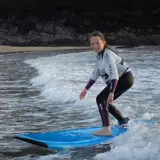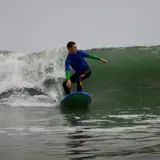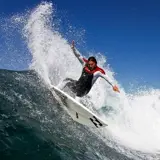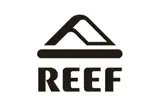Hey surfers! Today, we're going to talk about waves and how they are made, which is crucial for understanding the sport of surfing. Waves are the life force of surfing, so let's dive in and learn how they come to be! Here in Pembrokeshire, we are so lucky to have different types of waves right on our doorstep. When the open ocean swell reaches shallower water it becomes steeper and finally breaks into surf. Several factors influence the amount of growth that occurs from a deep water swell to a breaking wave. These include the angle of approach the swell makes with the shore, the configuration of shallow water bottom contours, the slope of the beach, and the deep water steepness of the wave (the ratio of wave height to wavelength).
First off, waves in the ocean are mainly created by wind. When strong winds blow across the surface of the water, they transfer their energy to the water, creating ripples. These ripples then develop into waves as they travel and interact with other waves. The size and quality of waves depend on several factors. One key factor is the speed and duration of the wind. Strong and consistent winds blowing over a long distance generate larger, more powerful waves. This is why you often find great waves in places with strong coastal winds or during storms. Another important factor is the "fetch," which refers to the distance of open water over which the wind blows. The longer the fetch, the more time the wind has to transfer its energy to the water, resulting in larger waves. For example, waves in the open ocean tend to be bigger than those near the shore because they have a longer fetch.
The shape and size of the ocean floor also play a significant role in wave formation. As waves approach shallow water near the shore, they interact with the seabed. This interaction causes the wave to slow down and compress, leading to an increase in wave height. It's this process that allows us to ride waves while surfing. Additionally, waves can be influenced by tides, underwater topography, and other environmental factors. For instance, reefs and sandbars can cause waves to break in specific ways, creating surfable conditions.
Now, as surfers, it's important to understand how to read and anticipate waves. Learning to observe the conditions, such as wind direction, wave height, and period (the time between two successive wave crests), helps us choose the right spot and time to catch the best waves. Remember, waves are dynamic and ever-changing, so learning how they are made and understanding their behavior is fundamental to becoming skilled surfers. So, let's continue our journey, riding those waves and experiencing the exhilaration of surfing!




































